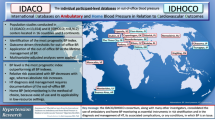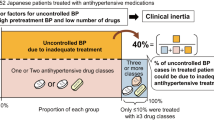Abstract
Purpose of Review
The paper examines the patterns of BP control achieved in two large scale observational studies, i.e., the Pressioni Arteriose Monitorate E Loro Associazioni (PAMELA) study and the Blood Pressure control rate and CArdiovascular Risk profilE (BP-CARE), carried out in the general population and in treated hypertensive patients, respectively.
Recent Findings
It is well known that only a minor fraction among the treated hypertensive patients exhibits a good blood pressure control. However, few study investigated blood pressure control on the basis not only of office, but also home and ambulatory blood pressure measurement, examining its impact on organ damage.
Summary
In the whole sample of the PAMELA study, only in about 21.1% of cases treated hypertensive subjects exhibit a well-controlled office BP. Control of systolic blood pressure was rarer than the diastolic one. Control of home and, even more, ambulatory blood pressure was more frequent. Left ventricular mass was not normalized even when blood pressure was adequately controlled. Most subjects of BP-CARE study show high or very high cardiovascular risk, due to concomitant risk factors and organ damage. The percentage of well-treated hypertensive patients is lower when CV risk is higher.

Similar content being viewed by others

References
Papers of particular interest, published recently, have been highlighted as: • Of importance •• Of major importance
Tocci G, Nati G, Cricelli C, Parretti D, Lapi F, Ferrucci A, et al. Prevalence and control of hypertension in the general practice in Italy: updated analysis of a large database. J Hum Hypertens. 2017 Apr;31(4):258–62. https://doi.org/10.1038/jhh.2016.71.
Shokeen D, Aeri BT. Prevalence of cardio-metabolic risk factors: a cross-sectional study among employed adults in urban Delhi. India J Clin Diagn Res. 2017 Aug;11(8):LC01–4. https://doi.org/10.7860/JCDR/2017/29087.10336.
Nag T, Ghosh A. Cardiovascular disease risk factor clustering among rural adult population in West Bengal. India Obes Res Clin Pract. 2016;10(2):124–32. https://doi.org/10.1016/j.orcp.2015.05.003.
Charles-Davies MA, Fasanmade AA, Olaniyi JA, Oyewole OE, Owolabi MO, Adebusuyi JR, et al. Metabolic alterations in different stages of hypertension in an apparently healthy Nigerian population. Int J Hypertens. 2013;2013:351357–6. https://doi.org/10.1155/2013/351357.
Mancia G, Facchetti R, Bombelli M, Polo Friz H, Grassi G, Giannattasio C, et al. Relationship of office, home, and ambulatory blood pressure to blood glucose and lipid variables in the PAMELA population. Hypertension. 2005;45(6):1072–7.
•• Mancia G, Verdecchia P. Clinical value of ambulatory blood pressure: evidence and limits. Circ Res. 2015;116(6):1034–45. https://doi.org/10.1161/CIRCRESAHA.116.303755. A review highlighting limits and streghts of ambulatory blood pressure monitoring.
Mancia G, Sega R, Bravi C, De Vito G, Valagussa F, Cesana G, et al. Ambulatory blood pressure normality: results from the PAMELA study. J Hypertens. 1995;13(12 Pt 1):1377–90.
Sega R, Cesana G, Milesi C, Grassi G, Zanchetti A, Mancia G. Ambulatory and home blood pressure normality in the elderly: data from the PAMELA population. Hypertension. 1997;30(1 Pt 1):1–6.
Grassi G, Cifkova R, Laurent S, Narkiewicz K, Redon J, Farsang C, et al. Blood pressure control and cardiovascular risk profile in hypertensive patients from central and eastern European countries: results of the BP-CARE study. Eur Heart J. 2011;32(2):218–25. https://doi.org/10.1093/eurheartj/ehq394.
Mancia G, De Backer G, Dominiczak A, Cifkova R, Fagard R, Germano G, et al. 2007 Guidelines for the management of arterial hypertension: the task force for the Management of Arterial Hypertension of the European Society of Hypertension (ESH) and of the European Society of Cardiology (ESC). J Hypertens. 2007 Jun;25(6):1105–87.
Mancia G, Sega R, Grassi G, Cesana G, Zanchetti A. Defining ambulatory and home blood pressure normality: further considerations based on data from the PAMELA study. J Hypertens. 2001 Jun;19(6):995–9.
Staessen JA, Fagard RH, Lijnen PJ, Thijs L, Van Hoof R, Amery AK. Mean and range of the ambulatory pressure in normotensive subjects from a meta-analysis of 23 studies. Am J Cardiol. 1991;67(8):723–7.
Kuznetsova T, Emelianov D, Staessen JA. Normality of ambulatory blood pressure. Blood Press Monit. 1999;4(5):227–31.
Ohkubo T, Imai Y, Tsuji I, Nagai K, Ito S, Satoh H, et al. Reference values for 24-hour ambulatory blood pressure monitoring based on a prognostic criterion: the Ohasama Study. Hypertension. 1998;32(2):255–9.
Kikuya M, Hansen TW, Thijs L, Björklund-Bodegård K, Kuznetsova T, Ohkubo T, et al. Diagnostic thresholds for ambulatory blood pressure monitoring based on 10-year cardiovascular risk. Circulation. 2007;115(16):2145–52.
O'Brien E, Parati G, Stergiou G, Asmar R, Beilin L, Bilo G, et al. European Society of Hypertension position paper on ambulatory blood pressure monitoring. J Hypertens. 2013 Sep;31(9):1731–68. https://doi.org/10.1097/HJH.0b013e328363e964.
•• Mancia G, Fagard R, Narkiewicz K, Redon J, Zanchetti A, Böhm M, et al. 2013 ESH/ESC guidelines for the management of arterial hypertension: the Task Force for the Management of Arterial Hypertension of the European Society of Hypertension (ESH) and of the European Society of Cardiology (ESC). Eur Heart J. 2013;34(28):2159–219. https://doi.org/10.1093/eurheartj/eht151. The latest guidelines for diagnosis and treatmen of hypertension.
Mancia G, Sega R, Milesi C, Cesana G, Zanchetti A. Blood-pressure control in the hypertensive population. Lancet. 1997;349(9050):454–7.
Mancia G, Bombelli M, Lanzarotti A, Grassi G, Cesana G, Zanchetti A, et al. Systolic vs diastolic blood pressure control in the hypertensive patients of the PAMELA population. Arch Intern Med. 2002 Mar 11;162(5):582–6.
• Cuspidi C, Sala C, Casati A, Bombelli M, Grassi G, Mancia G. Clinical and prognostic value of hypertensive cardiac damage in the PAMELA Study. Hypertens Res. 2017;40(4):329–35. https://doi.org/10.1038/hr.2016.153. A paper reviewing the most recent results of the PAMELA study in relation with cardiac hypertrophy.
Mancia G, Carugo S, Grassi G, Lanzarotti A, Schiavina R, Cesana G, et al. Prevalence of left ventricular hypertrophy in hypertensive patients without and with blood pressure control: data from the PAMELA population. Pressioni Arteriose Monitorate E Loro Associazioni. Hypertension. 2002 Mar 1;39(3):744–9.
Blacher J, Evans A, Arveiler D, Amouyel P, Ferrières J, Bingham A, et al. Residual cardiovascular risk in treated hypertension and hyperlipidaemia: the PRIME Study. J Hum Hypertens. 2010 Jan;24(1):19–26. https://doi.org/10.1038/jhh.2009.34.
• Taverny G, Mimouni Y, LeDigarcher A, Chevalier P, Thijs L, Wright JM, et al. Antihypertensive pharmacotherapy for prevention of sudden cardiac death in hypertensive individuals. Cochrane Database Syst Rev. 2016;3:CD011745. https://doi.org/10.1002/14651858.CD011745.pub2. A recently published meta-analysis on sudden death in hypertension.
Bliziotis IA, Destounis A, Stergiou GS. Home versus ambulatory and office blood pressure in predicting target organ damage in hypertension: a systematic review and meta-analysis. J Hypertens. 2012 Jul;30(7):1289–99. https://doi.org/10.1097/HJH.0b013e3283531eaf.
Mancia G, Zanchetti A, Agabiti-Rosei E, Benemio G, De Cesaris R, Fogari R, et al. Ambulatory blood pressure is superior to clinic blood pressure in predicting treatment-induced regression of left ventricular hypertrophy. SAMPLE Study Group. Study on Ambulatory Monitoring of Blood Pressure and Lisinopril Evaluation. Circulation. 1997;95(6):1464–70.
Karpettas N, Destounis A, Kollias A, Nasothimiou E, Moyssakis I, Stergiou GS. Prediction of treatment-induced changes in target-organ damage using changes in clinic, home and ambulatory blood pressure. Hypertens Res. 2014;37(6):543–7. https://doi.org/10.1038/hr.2014.24.
Boggia J, Li Y, Thijs L, Hansen TW, Kikuya M, Björklund-Bodegård K, et al. Prognostic accuracy of day versus night ambulatory blood pressure: a cohort study. Lancet. 2007;370(9594):1219–29.
• Sharman JE, Boutouyrie P, Laurent S. Arterial (aortic) stiffness in patients with resistant hypertension: from assessment to treatment. Curr Hypertens Rep. 2017;19(1):2. https://doi.org/10.1007/s11906-017-0704-7. An updated review on vascular alterations in resistant hypertension.
Author information
Authors and Affiliations
Corresponding author
Ethics declarations
Conflict of Interest
Dr. Mancia reports personal fees from Boehringer Ingelheim, Daiichi Sankyo, Ferrer, Medtronic, Menarini, Merck, Novartis, RecordatI, and Servier outside the submitted work. The other authors declare no conflicts of interest relevant to this manuscript.
Human and Animal Rights and Informed Consent
This article does not contain any studies with human or animal subjects performed by any of the authors.
Additional information
This article is part of the Topical Collection on Blood Pressure Monitoring and Management
Rights and permissions
About this article
Cite this article
Bombelli, M., Facchetti, R., Mancia, G. et al. Big Data and Blood Pressure Control: Insights from the PAMELA and BP-CARE Study Cohorts. Curr Hypertens Rep 20, 82 (2018). https://doi.org/10.1007/s11906-018-0885-8
Published:
DOI: https://doi.org/10.1007/s11906-018-0885-8



